Every single spot on the earth can be identified by a global latitude and longitude coordinate system - whoa, big words, dude!
Well, let's slow down a bit. Latitude and longitude are just used to pinpoint your location. Translating the earth to a map requires some sort of agreed-upon way to describe each spot.
Take a look at this map:
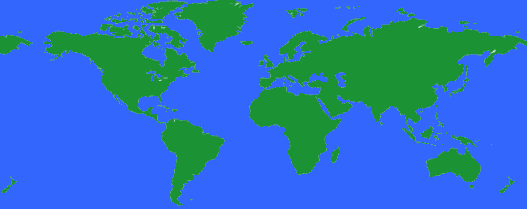
Obviously, that is a map of the earth. You can find the continents and can probably make a good try at pointing to where you live. But, how could you tell someone else where you live so they could quickly find it on their own map? That is where a coordinate system helps.
The Axis
Our coordinate system is going to be based on the spinning earth. The earth spins around on its axis. One end of the axis is the North Pole and the other is the South Pole. These are the two most important points on earth as far as directions and navigating are concerned.
The most important number for figuring out locations is 360. There are 360 degrees in a circle and that is the shape of our world, no matter how you slice it.
Latitude
If you could stand at the center of the earth, you could look out at the surface of the earth all around you. With the North Pole directly above your head, if you looked straight ahead in any direction, you would be looking at the equator. This imaginary line is exactly halfway between the north and south poles and has a latitude of 0 degrees because you are looking straight ahead at an angle of 0 degrees. If you look up a bit, maybe at an angle of 30 degrees, you have increased your latitude to 30 degrees North. Continue to look up higher and higher until you are looking straight above you at the north pole which is 90 degrees North.
Maybe this image will help:
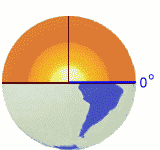
The same thing happens if you look down under the equator. The degrees increase until you are looking straight below you at the south pole which is at 90 degrees south latitude.
Just like the equator is a line drawn around the earth at 0 degrees latitude, you can draw a line around the earth at any latitude. Draw a lot of these lines and you will see something like this:
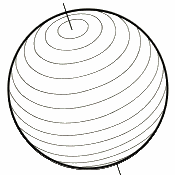
90 degrees north and 90 degrees south are are actually just points, not circles. Notice that each latitude is parallel to all others. The actual distance between latitudes is always the same. But, since greater latitudes are closer to the poles, circumferences get smaller as latitudes increase.
Drawing those latitude lines onto a map would look like this:
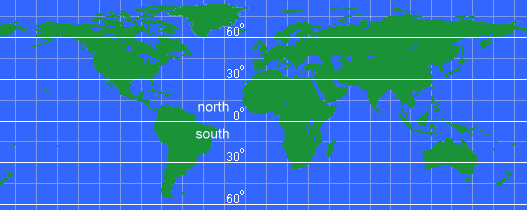
Longitude
Longitude is the angle east or west around the earth, just like latitude is the angle north and south. Longitude lines are called meridians.
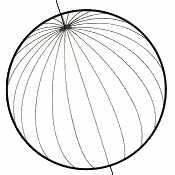
For latitudes, we have two fixed points - the north and south poles - that we use as end points. But, going around the earth, there is no start or stop, it just keeps spinning and spinning. So, an arbitrary spot was chosen to be the Start point for longitudes. This spot is the Royal Observatory in Greenwich, UK. The longitude line that runs through it is called the Prime Meridian and is longitude zero degrees.
Notice that longitude lines are not parallel. The closer to the poles you get, the shorter the distance between meridians until they all actually converge at the poles.
Drawing those longitude lines onto a map would look like this:
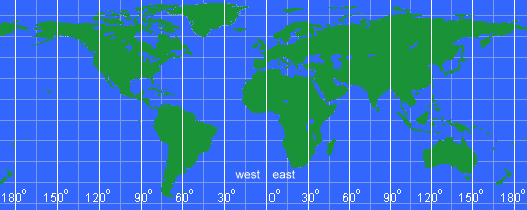
Latitude and Longitude Grid
Combining latitude and longitude results in a grid that covers the globe. Every point can be defined by a north/south degree and an east/west degree.
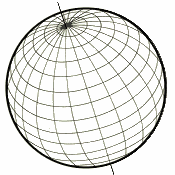
For example, Seattle, Washington, USA is at latitude 47.6° North and longitude 122.33° West. From the center of the earth, look up 46.6° from the equator and turn right (west) 122.33° from the Prime Meridiean and you will be looking right at Seattle.
And, the complete grid on a map looks like:
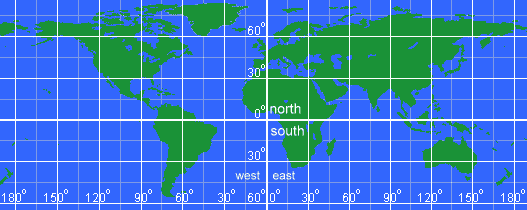
Well, degrees are fine and good, but the earth is almost 25000 miles around so dividing that into 360 pieces means each degree is about 69 miles wide around the equator. That isn't very precise. To help with that, each degree is divided into 60 minutes and each minute is divided into 60 seconds. These used to be used all the time, but now fractional degrees are more common.
For example, the location of the White House in Washington, DC is:
| Decimal Degrees | Deg:Min:Sec | |
| Lat: | 38.898648N | 38° 53' 55.133" N |
| Lon: | 77.037692W | 77° 02' 15.691" W |
USGS topographic maps are called 7.5 minute maps because they span 7.5 minutes of latitude and 7.5 minutes of longitude. The most common latitude and longitude map is a 1:24,000 scale and the actual map size is about 22 inches by 27 inches. By the way, it takes about 57,000 of these maps to cover the entire US and you can buy any of them you want. Start your collection today! :-)
That's about all there is to latitude and longitude coordinates! Here's some tips to remember:
- Latitude is always given before longitude (49° N 100° E)
- Latitudes are parallel, but longitudes are not
- Degrees West and South are sometimes referred to as negative degrees (-12° -23° is the same as 12 S 23 W)
- A place's latitude effects its climate, but its longitude does not
- Key longitude lines are the Prime Meridian (0°) and the International Date Line (180°)
- Key latitude lines include the equator (0°), tropic of cancer (23° 26' N), tropic of capricorn (23° 26' S), the arctic circle (66° 33' N), and the antarctic circle (66° 33' S)
- Find your location from your latitude/longitude at this pag
No comments:
Post a Comment